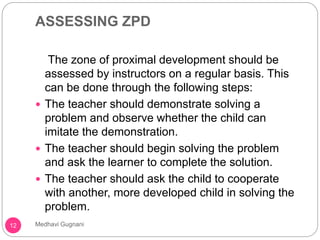Understanding the Learner
- 2. INDIVIDUAL DIFFERENCES Individual differences refers to the extent and kind of variations or similarities among people on some of the important psychological aspects such as intelligence, personality, interest, and aptitude. Every learner is different and so are their needs. 2 Medhavi Gugnani
- 3. ROLE OF REWARDS IN LEARNING Is delivered contingently. Pairing a piece of candy (tangible reward) or verbal praise (intangible reward) withcompleting a class assignment may enhance performance of the class assignment and cause participants to feel competent because they completed the assignment. Specifies the particulars of the accomplishments. That is, to be told “You're a good test taker.” (the personal attribute is test taking) versus "You did a good job on this test.” (the performance is a “good job” on the test) can be detrimental to personality functioning and can decrease interest and performance. Shows spontaneity, variety, and other signs of credibility; suggests clear attention to the students accomplishment.- “you earned the honor of being class leader next week for accomplishing level 2 of the rubric, your best work yet.” Is given in recognition of noteworthy effort or success at 3 Medhavi Gugnani
- 4. ROLE OF REINFORCEMENT IN LEARNING REINFORCEMENT A simple definition of reinforcement is something that happens after a behavior that makes the behavior more likely to occur again. Reinforcers can take many forms, including tangible items such as stickers or small prizes, and intangible motivators, such as social activities, sensory activities or special privileges. Every class is different, and several types of reinforcers may be used to motivate different students. Before beginning any reinforcement system, it is a good idea to survey students to find out what they find motivating4 Medhavi Gugnani
- 5. Token economy A token economy is a system in which students earn some type of a token that can be exchanged later for a specific reinforcer. If you choose to use a token economy, you will need to carefully plan the logistics of the system. Token economies can be very complex, but a few rules of thumb will help to make the system manageable. 5 Medhavi Gugnani
- 6. DISCOVERY LEARNING Discovery learning refers to various instructional design models that engages students in learning through discovery. According to van Joolingen (1999:385): “ Discovery learning is a type of learning where learners construct their own knowledge by experimenting with a domain, and inferring rules from the results of these experiments. The basic idea of this kind of learning is that because learners can design their own experiments in the domain and infer the rules of the domain themselves they are actually constructing their knowledge. Because of these constructive activities, it is assumed they will understand the domain at a higher level than when the necessary6 Medhavi Gugnani
- 7. DISCOVERY LEARNING IN PRACTICE The Pedagogical aims are threefold: (1) Promote "deep" learning (2) Promote meta-cognitive skills (develop problem-solving skills, creativity, etc.) (3) Promote student engagement. Discovery Learning provides students with opportunities to develop hypotheses to answer questions and can contribute to the development of a lifelong love of learning. Students propose issues or problems, gather data and observations to develop hypotheses, confirm or refine their hypotheses, and explain or prove their problems. Discovery learning is based on this "Aha!" method. 7 Medhavi Gugnani
- 8. ZONE OF PROXIMAL DEVELOPMENT (ZPD) Vygotsky also introduced the idea that children can perform more challenging tasks when assisted by more advanced and competent individuals. Vygotsky identified two levels of development: actual development, which is the upper limit of tasks a child can perform individually, and level of potential development, which is the upper limit of tasks a child can perform with the assistance of a more competent individual. According to Vygotsky, in order to get a true assessment of a child's actual and potential development, we should assess capabilities both when the child is performing the activity alone and with a more competent individual. 8 Medhavi Gugnani
- 9. For example, our young child exhibited that her actual development was that she knew the blocks belonged in the holes, but she couldn't quite determine how to actually put them in. Her level of potential development was being able to put the blocks in with the help of her father, an advanced individual 9 Medhavi Gugnani
- 10. Our next assumption is that challenging tasks promote maximum cognitive growth. Vygotsky described this as the zone of proximal development , or commonly referred to as ZPD. ZPD is the range of tasks that a child can perform with the help and guidance of others but cannot yet perform independently. 10 Medhavi Gugnani
- 11. SCAFFOLDING Scaffolding is directly related to zone of proximal development in that it is the support mechanism that helps a learner successfully perform a task within his or her ZPD. Typically, this process is completed by a more competent individual supporting the learning of a less competent individual. So, for example, there could be a teacher assisting a student, or a higher-level peer assisting a younger peer. Giving clues on how to solve an equation is an example of scaffolding Scaffolding is applied similarly in the classroom. First, the teacher should provide clues about how to proceed through the problem. As the child becomes capable of solving the problem without support, the teacher gradually removes these clues. This process is referred to as fading. 11 Medhavi Gugnani
- 12. ASSESSING ZPD The zone of proximal development should be assessed by instructors on a regular basis. This can be done through the following steps: The teacher should demonstrate solving a problem and observe whether the child can imitate the demonstration. The teacher should begin solving the problem and ask the learner to complete the solution. The teacher should ask the child to cooperate with another, more developed child in solving the problem. 12 Medhavi Gugnani
- 13. THANK YOU! 13 Medhavi Gugnani
Editor's Notes
- #8: Solving through trial and error.













